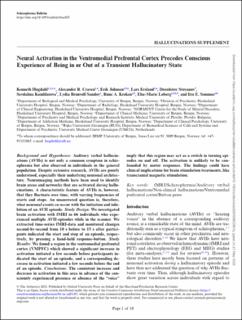| dc.description.abstract | Background and Hypotheses
Auditory verbal hallucinations (AVHs) is not only a common symptom in schizophrenia but also observed in individuals in the general population. Despite extensive research, AVHs are poorly understood, especially their underlying neuronal architecture. Neuroimaging methods have been used to identify brain areas and networks that are activated during hallucinations. A characteristic feature of AVHs is, however, that they fluctuate over time, with varying frequencies of starts and stops. An unanswered question is, therefore, what neuronal events co-occur with the initiation and inhibition of an AVH episode.
Study Design
We investigated brain activation with fMRI in 66 individuals who experienced multiple AVH-episodes while in the scanner. We extracted time-series fMRI-data and monitored changes second-by-second from 10 s before to 15 s after participants indicated the start and stop of an episode, respectively, by pressing a hand-held response-button.
Study Results
We found a region in the ventromedial prefrontal cortex (VMPFC) which showed a significant increase in activation initiated a few seconds before participants indicated the start of an episode, and a corresponding decrease in activation initiated a few seconds before the end of an episode.
Conclusions
The consistent increase and decrease in activation in this area in advance of the consciously experienced presence or absence of the “voice” imply that this region may act as a switch in turning episodes on and off. The activation is unlikely to be confounded by motor responses. The findings could have clinical implications for brain stimulation treatments, like transcranial magnetic stimulation. | en_US |

